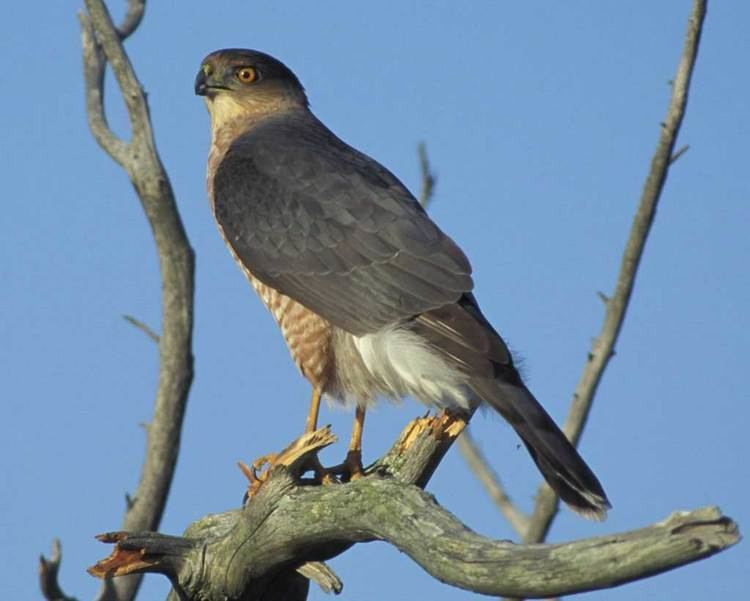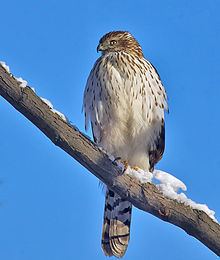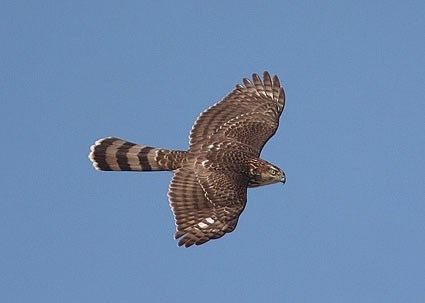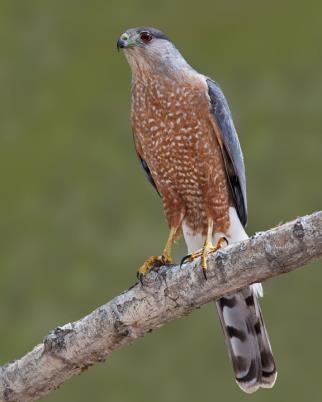Higher classification Accipiter | Phylum Chordata Scientific name Accipiter cooperii Rank Species | |
 | ||
Similar Bird, Sharp‑shinned hawk, Red‑tailed hawk, Accipiter, Red‑shouldered hawk | ||
Cooper s hawk kills dove at bird feeder
Cooper's hawk (Accipiter cooperii) is a medium-sized hawk native to the North American continent and found from Southern Canada to Northern Mexico. As in many birds of prey, the male is smaller than the female. The birds found east of the Mississippi River tend to be larger on average than the birds found to the west. Other common names for the Cooper's hawk include: big blue darter, chicken hawk, flying cross, hen hawk, quail hawk, striker, and swift hawk.
Contents
- Cooper s hawk kills dove at bird feeder
- Cooper s hawk attacks bird feeder
- Taxonomy
- Description
- Distribution and habitat
- Feeding
- Courtship
- Breeding
- Communication
- Lifespan
- Status and conservation
- References

Cooper s hawk attacks bird feeder
Taxonomy

Cooper's hawk was first described by French naturalist Charles Lucien Bonaparte in 1828. It is a member of the goshawk genus Accipiter. This bird was named after the naturalist William Cooper, one of the founders of the New York Lyceum of Natural History (later the New York Academy of Sciences) in New York. Other common names; big blue darter, chicken hawk, hen hawk, Mexican hawk, quail hawk, striker and swift hawk.
Description

The average mass of an adult male ranges from 220 to 440 g (7.8 to 15.5 oz) with a length between 35 and 46 cm (14 and 18 in). The adult male is significantly smaller than the average female, which weigh 330 to 700 g (12 to 25 oz) and measure 42 to 50 cm (17 to 20 in) long. Its wingspan ranges from 62 to 94 cm (24 to 37 in). Individuals living in the eastern regions, where the sexes average 349 g (12.3 oz) and 566 g (20.0 oz), tend to be larger and heavier than those in the western regions, where the respective sexes average 280 g (9.9 oz) and 440 g (16 oz).
Cooper's hawks have short rounded wings, the wing chord measuring 21.4–27.8 cm (8.4–10.9 in) long, and a relatively long tail, 17–20.5 cm (6.7–8.1 in) long, with dark bands, round-ended at the tip. As in most accipiters, the tarsus is relatively long, measuring 5.6–7.6 cm (2.2–3.0 in) long, and the bill is relatively small, with the culmen from the cere measuring only 1.5–2.1 cm (0.59–0.83 in). Adults have red eyes and have a black cap, with blue-gray upper parts and white underparts with fine, thin, reddish bars. Their tail is blue-gray on top and pale underneath, barred with black bands.

Immatures have yellow eyes and have a brown cap, with brown upper parts and pale underparts with thin black streaks mostly ending at the belly. Their tail is brown on top and pale underneath, barred with dark bands. The eyes of this hawk, as in most predatory birds, face forward, enabling good depth perception for hunting and catching prey while flying at top speeds. They have hooked bills that are well adapted for tearing flesh of prey. Immatures are somewhat larger than a sharp-shinned hawk and smaller than a northern goshawk, though small males nearly overlap with large female sharp-shinned hawks, and large female Cooper's hawks nearly overlap with small male goshawks. Although the coloration is generally somewhat similar between sharp-shinned hawks and Cooper's hawks, Cooper's appear broader-chested and larger-headed, with generally more robust features. The crow-like size of Cooper's hawks is sometimes distinctive from the sharp-shinned, but this can be less reliable in large female sharp-shinneds. Goshawks are usually more distinctive in their larger size and differing plumage markings, with the juvenile goshawk having broader, darker streaking below with more irregular patterns than the immature Cooper's. The Cooper's hawk appears long-necked in flight and has been described by birdwatchers as looking like a "flying cross". The Cooper's hawk is seen mostly flying with quick, consecutive wing beats and a short glide, though they may also soar.
Distribution and habitat

Their breeding range extends from southern Canada to northern Mexico. They are generally distributed more to the south than the other North American accipiters, the sharp-shinned hawk and the northern goshawk. Birds from most of the Canadian and northern U.S. range migrate in winter, and some Cooper's hawks winter as far south as Panama. The Cooper's hawk occur in various types of mixed deciduous forests and open woodlands, including small woodlots, riparian woodlands in dry country, open and pinyon woodlands, and forested mountainous regions and also now nests in many cities. They were once thought to be averse to cities and towns, but are now fairly common urban and suburban birds. The cities provide plenty of rock pigeon and mourning dove for the Cooper's hawk to prey on. Although more adapatable in habitat than the sharp-shinned hawk, studies have indicated that the species still more often than not prefers sizeable tracts of woodland for breeding and migrating to fragmented, developed areas.
Feeding
These birds capture prey from cover or while flying quickly through dense vegetation, relying almost totally on surprise. One study showed that this is a quite dangerous hunting style. More than 300 Cooper's hawk skeletons were investigated and 23% revealed healed fractures in the bones of the chest. Cooper's hawks prey almost exclusively on small to mid-sized birds. Typical prey species include American robins, other thrushes, jays, woodpeckers, European starlings, quail, icterids, cuckoos, pigeons and doves. Birds preyed on can range in size from wood-warblers to ring-necked pheasants. They may also prey upon the raptor American kestrel and other smaller raptors, including their cousin the sharp-shinned hawk. They have been known to rob nests and may supplement their diet with small mammals such as chipmunks, hares, mice, squirrels, and bats. Even more rarely, they may prey on lizards, frogs, or snakes. It normally catches its prey with its feet and kills it by repeatedly squeezing it and holding it away from its body until it dies. They have also been seen drowning their prey, holding it underwater until it stops moving. The hawks often pluck the feathers off their prey on a post or other perch. They also hunt songbirds at backyard feeders, perching nearby then swooping down and scattering the birds to single one out in flight. They may pursue prey on the ground by half running and half flying.
Courtship
The Cooper's hawks are monogamous, but most do not mate for life. Pairs will breed once a year and raise one brood per breeding season. Courtship displays include stylized flights with the wings positioned in a deep arc. During their flight displays the male will begin by diving toward the female. A slow speed-chase follows involving the male flying around the female exposing his expanded under tail coverts to her. The male raises his wings high above the back and flies in a wide arc with slow, rhythmic flapping. Courting usually occurs on bright, sunny days, in midmorning. After pairing has occurred, the males make a bowing display before beginning to build the nest.
Breeding
Their breeding habitats are forested areas. The breeding pair builds a stick nest in large trees. Over a two-week period the pair builds the nest. The nests are piles of sticks around 70 cm (28 in) in diameter and 15–43 cm (5.9–16.9 in) high with a cup-shaped depression in the middle that is 20 cm (8 in) across and 10 cm (4 in) deep. Their nests are built in pines, oaks, Douglas firs, beeches, spruces, and other tree species usually on flat ground rather than on a hillside. The nests typically are about 7.6–15.1 m (25–50 ft) high off the ground, halfway up the tree, and out on a horizontal branch. The clutch size is usually 3 to 5 eggs. The cobalt-blue eggs average about 48 mm × 38 mm (1.9 in × 1.5 in) and weigh about 43 g (1.5 oz). The female incubates the eggs between 30 and 36 days. The hatchlings are about 28 g (0.99 oz) and 9 cm (3.5 in) long and are completely covered in white down. They are brooded for about two weeks by the female, while her mate forages for food. The fledging stage is reached at 25 to 34 days of age, though the offspring will return to the nest to be fed until they become independent around 8 weeks. Eggs and nestlings are preyed on, rarely, by raccoons, crows as well as other competing Cooper's hawks. Adults rarely fall prey to larger raptors, namely red-tailed hawks, great horned owls, peregrine falcons, golden eagles, and northern goshawks.
Communication
Cooper's hawks communicate using vocalizations and displays. Vocal is probably preferred over display, because the denseness of their habitat could prevent displays from being seen from a distance. Males are usually submissive to females and will listen for reassuring call notes the females make when they are willing to be approached. The males have a higher pitched voice than females.
Lifespan
Cooper's hawks live as long as 12 years in the wild. The oldest known Cooper's hawk was 20 years and 4 months old.
Status and conservation
At one time, Cooper's hawks were heavily hunted in persecution for preying on poultry and were called chicken hawks. It is now known that predation by these hawks on domestic animals borders on negligible, and they are rarely hunted currently.{cn|date=February 2017}}
Cooper's hawks' breeding success was also reduced by the use of the pesticide DDT, but the ban of DDT ended that threat. Since then, the adaptable Cooper's hawk has thrived. However, one threat facing Cooper's hawks today is the degradation and loss of habitat. Management activities like logging may make their former habitat unsuitable for breeding. As a natural predator of almost any North American bird smaller than itself, the Cooper's hawk can inadvertently deplete populations of rarer, conservation-dependent species. The American kestrel, whose populations have experienced considerable decrease, is one species which has suffered from the extensive predation of the recovered Cooper's hawk population.
